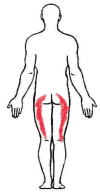Effect of Neuromuscular Training and Neurodynamic Solutions for Asymptomatic Prolapsed Intervertebral Disc and Coexisting Piriformis Syndrome in a 19-Year-Old: A Comprehensive Case Report
- PMID: 38410291
- PMCID: PMC10896010
- DOI: 10.7759/cureus.53050
Effect of Neuromuscular Training and Neurodynamic Solutions for Asymptomatic Prolapsed Intervertebral Disc and Coexisting Piriformis Syndrome in a 19-Year-Old: A Comprehensive Case Report
Abstract
This case study examines the treatment journey of a 19-year-old male who presented with bilateral buttock pain, lower limb weakness, and instability caused by piriformis syndrome and asymptomatic Prolapsed intervertebral disc (PIVD) herniation. The intervention strategy was guided by clinical assessments, including neurological and musculoskeletal evaluations, as well as confirmatory magnetic resonance imaging (MRI) findings. The patient's treatment plan adopted a comprehensive approach that incorporated neuromuscular training and neurodynamic solutions. The former focused on strengthening the core and lower limb muscles to correct biomechanical imbalances associated with piriformis syndrome. Concurrently, neurodynamic solutions, such as targeted stretching and mobilization exercises, were employed to alleviate sciatic nerve compression related to asymptomatic PIVD. The results demonstrated significant improvement in symptoms, highlighting the effectiveness of the individualized rehabilitation program. This case report underscores the success of a multifaceted approach in addressing the intricate interaction between muscular and neural components in piriformis syndrome and asymptomatic PIVD. However, further research is necessary to validate the broader applicability of this combined therapeutic strategy.
Keywords: neurodynamic solutions; neuromuscular training; piriformis syndrome; prolapsed intervertebral disc; rehabilitation; sciatica.
Copyright © 2024, Ankar et al.
Conflict of interest statement
The authors have declared that no competing interests exist.
Figures
Similar articles
-
Microdiscectomy compared with transforaminal epidural steroid injection for persistent radicular pain caused by prolapsed intervertebral disc: the NERVES RCT.Health Technol Assess. 2021 Apr;25(24):1-86. doi: 10.3310/hta25240. Health Technol Assess. 2021. PMID: 33845941 Free PMC article. Clinical Trial.
-
Treatment of an individual with piriformis syndrome focusing on hip muscle strengthening and movement reeducation: a case report.J Orthop Sports Phys Ther. 2010 Feb;40(2):103-11. doi: 10.2519/jospt.2010.3108. J Orthop Sports Phys Ther. 2010. PMID: 20118521
-
Impact of Dorn Therapy on a Patient With a Prolapsed Intervertebral Disc: A Case Report.Cureus. 2022 Sep 11;14(9):e29023. doi: 10.7759/cureus.29023. eCollection 2022 Sep. Cureus. 2022. PMID: 36249665 Free PMC article.
-
Physiotherapy for Piriformis Syndrome Using Sciatic Nerve Mobilization and Piriformis Release.Cureus. 2022 Dec 26;14(12):e32952. doi: 10.7759/cureus.32952. eCollection 2022 Dec. Cureus. 2022. PMID: 36712711 Free PMC article. Review.
-
Case report and review of the potential role of the Type A piriformis muscle in dynamic sciatic nerve entrapment variant of piriformis syndrome.Surg Radiol Anat. 2020 Oct;42(10):1237-1242. doi: 10.1007/s00276-020-02440-8. Epub 2020 Feb 28. Surg Radiol Anat. 2020. PMID: 32112284 Review.
References
-
- Lumbar disc nomenclature: version 2.0: recommendations of the combined task forces of the North American Spine Society, the American Society of Spine Radiology and the American Society of Neuroradiology. Fardon DF, Williams AL, Dohring EJ, Murtagh FR, Gabriel Rothman SL, Sze GK. Spine J. 2014;14:2525–2545. - PubMed
-
- Radiculopathy and the herniated lumbar disc. Controversies regarding pathophysiology and management. Rhee JM, Schaufele M, Abdu WA. J Bone Joint Surg Am. 2006;88:2070–2080. - PubMed
-
- The epidemiology and pathophysiology of lumbar disc herniations. Schroeder GD, Guyre CA, Vaccaro AR. Semin Spine Surg. 2016;28:2–7.
-
- Dydyk AM, Massa RN, Mesfin FB. In: StatPearls. Treasure Island, FL: StatPearls Publishing; 2023. Disc herniation. - PubMed
-
- Nedresky D, Reddy V, Singh G. In: StatPearls. Treasure Island, FL: StatPearls Publishing; 2023. Anatomy, back, nucleus pulposus. - PubMed
Publication types
LinkOut - more resources
Full Text Sources
Medical


